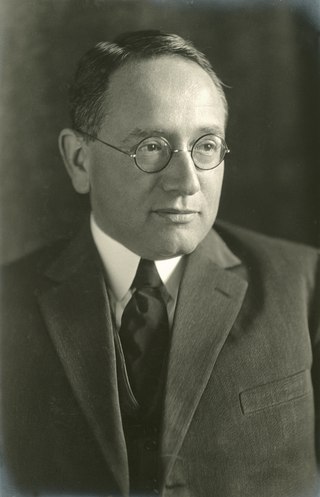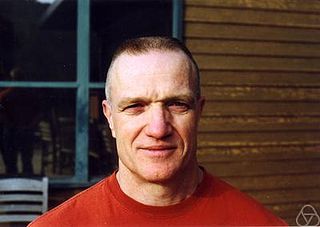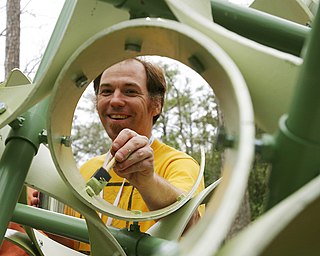
George Pólya was a Hungarian-American mathematician. He was a professor of mathematics from 1914 to 1940 at ETH Zürich and from 1940 to 1953 at Stanford University. He made fundamental contributions to combinatorics, number theory, numerical analysis and probability theory. He is also noted for his work in heuristics and mathematics education. He has been described as one of The Martians, an informal category which included one of his most famous students at ETH Zurich, John von Neumann.

The American Mathematical Society (AMS) is an association of professional mathematicians dedicated to the interests of mathematical research and scholarship, and serves the national and international community through its publications, meetings, advocacy and other programs.

Thomas Francis Banchoff is an American mathematician specializing in geometry. He is a professor at Brown University, where he has taught since 1967. He is known for his research in differential geometry in three and four dimensions, for his efforts to develop methods of computer graphics in the early 1990s, and most recently for his pioneering work in methods of undergraduate education utilizing online resources.

Noga Alon is an Israeli mathematician and a professor of mathematics at Princeton University noted for his contributions to combinatorics and theoretical computer science, having authored hundreds of papers.
Tristan Needham is a British mathematician and professor of mathematics at the University of San Francisco.

Robert Leamon Bryant is an American mathematician. He works at Duke University and specializes in differential geometry.
The Euler Book Prize is an award named after Swiss mathematician and physicist Leonhard Euler (1707–1783) and given annually at the Joint Mathematics Meetings by the Mathematical Association of America to an outstanding book in mathematics that is likely to improve the public view of the field.
Sylvia D. Trimble Bozeman is an African American mathematician and Mathematics educator.
Doris J. Schattschneider is an American mathematician, a retired professor of mathematics at Moravian College. She is known for writing about tessellations and about the art of M. C. Escher, for helping Martin Gardner validate and popularize the pentagon tiling discoveries of amateur mathematician Marjorie Rice, and for co-directing with Eugene Klotz the project that developed The Geometer's Sketchpad.
Gerald Lee Alexanderson (1933–2020) was an American mathematician. He was the Michael & Elizabeth Valeriote Professor of Science at Santa Clara University, and in 1997–1998 was president of the Mathematical Association of America. He was also president of The Fibonacci Association from 1980 to 1984.

Svetlana Yakovlevna Jitomirskaya is a mathematician working on dynamical systems and mathematical physics. She is a distinguished professor of mathematics at Georgia Tech and UC Irvine. She is best known for solving the ten martini problem along with mathematician Artur Avila.

Colm Mulcahy is an Irish mathematician, academic, columnist, book author, public outreach speaker, amateur magician and Professor Emeritus at Spelman College. In addition to algebra, number theory, and geometry, his interests include mathemagical card magic and the culture of mathematics–particularly the contributions of Irish mathematicians and also the works of iconic mathematics writer Martin Gardner.
Talithia D. Williams is an American statistician and mathematician at Harvey Mudd College who researches the spatiotemporal structure of data. She was the first black woman to achieve tenure at Harvey Mudd College. Williams is an advocate for engaging more African Americans in engineering and science.

Chaim Goodman-Strauss is an American mathematician who works in convex geometry, especially aperiodic tiling. He retired from the faculty of the University of Arkansas and currently serves as outreach mathematician for the National Museum of Mathematics. He is co-author with John H. Conway and Heidi Burgiel of The Symmetries of Things, a comprehensive book surveying the mathematical theory of patterns.

Marie A. Vitulli is an American mathematician and professor emerita at the University of Oregon.

Emily Riehl is an American mathematician who has contributed to higher category theory and homotopy theory. Much of her work, including her PhD thesis, concerns model structures and more recently the foundations of infinity-categories. She is the author of two textbooks and serves on the editorial boards of three journals.
Autumn Kent is an American mathematician specializing in topology and geometry. She is a professor of mathematics and Vilas Associate at the University of Wisconsin. She is a transgender woman and a promoter of trans rights.
Candice Renee Price is an African-American mathematician and co-founder of the website Mathematically Gifted & Black, which features the contributions of modern-day black mathematicians. She is an advocate for women and people of color in STEM.
Spectra is a professional association of LGBTQIA+ mathematicians. It arose from a need for recognition and community for Gender and Sexual Minority mathematicians.
Hortensia Soto is a Mexican–American mathematics educator, and a professor of mathematics at Colorado State University. In May 2018, she was appointed Associate Secretary of the Mathematical Association of America (MAA).










